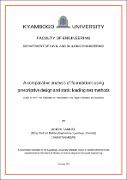| dc.description.abstract | Foundations for overhead transmission line lattice towers are subjected to overturning
loads imposed by winds and impact. Hence, they are designed to resist uplift, compression,
lateral and interconnection cable line-tension forces. However, due to the non-linear nature
of the load-displacement response for typical transmission line foundations, uncertainties
in subsoil behavior and design models, variations in soil strata, limits of site explorations,
and diversity in construction methodologies, the performance of the full scale foundation
model was analyzed using the reliability-based Static loading test methods.
The researcher used prescriptive design methods in geotechnical investigations, insitu and
laboratory tests, geotechnical and structural designs using the load and resistance factor
design approach, computer aided design tools, and static load test methods of static axial
tensile, static axial compressive, and lateral load tests, to replicate and validate the
foundation’s insitu long-term sustained load capacity and subsequent displacements.
The findings showed moderately aggressive chemical and environmental conditions, fine-grained
soils with low swell potential and medium-dense to hard soil consistencies under
0.3-10m ground water table levels. The static load test results showed a 20% increase in
design efficiency, 15-35% cost savings, and 80% reduced displacement overdesigns based
on the insitu displacement values of less than 20% of the prescriptive design values.
Although this research has advanced the understanding about transmission line foundation
designs using prescriptive design and static loading test methods, further research must be
done in quantifying the influence of ambient temperature, weather variations, and rate of
insitu backfill-soil compaction on static load test results.
Key words: Foundations, Prescriptive design, Static load test, Transmission Towers | en_US |

